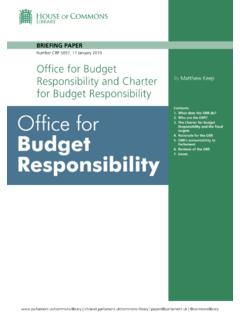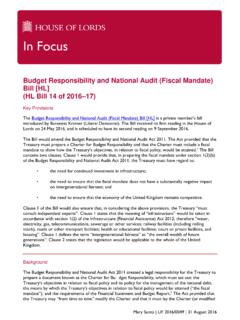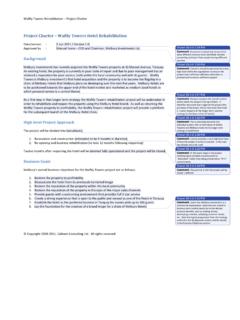Transcription of Public Charter School Fiscal Impact on School Districts
1 1 Legislative budget and Finance Committee Public Charter School Fiscal Impact on School Districts Report Presentation by Dr. Maryann Nardone at May 24, 2017, Meeting Good morning. Last year, the Officers of the Legislative budget & Finance Committee adopted a study of the financial Impact of Public Charter schools on Pennsylvania s School Districts . The Officers also directed the study include paren-tal reasons for placing their children in Charter schools. We found: Pennsylvania is one of 43 states with laws providing for Public Charter schools, and one of 24 states with legislation explicitly providing for cyber Charter schools. In 2015, about 135,000 special education and nonspecial education stu-dents were enrolled in brick and mortar and cyber Charter schools in Pennsylva-nia, with virtually all of the state s Public School Districts having at least one stu-dent enrolled at a Charter School .
2 Ten percent (51 School Districts ) of the state s School Districts had more than 5 percent of their student average daily membership enrolled in Charter schools; these 51 Districts accounted for about 80 percent of the state s total Charter School enrollment. The City of Philadelphia School district accounted for one-half of the state s total Charter School enrollment, and the Chester Upland School district had the highest proportion (over one-half) of district students enrolled in Charter schools. 2 The other 49 School Districts with high Charter School enrollments, however, are found in all corners of the state and include small, rural, suburban, and large urban Districts . Over 40 percent (22 of 51) of the Districts with significant Charter enrollment are known to be facing Fiscal challenges. They include 12 Districts that requested and received approval from the Pennsylvania Department of Education (PDE) to raise their 2016-17 School real estate taxes above the Taxpayer Relief Act index in-tended to serve as a cap on each School district s allowable tax increase, and an ad-ditional nine School Districts , plus the City of Philadelphia School district , that have been recognized by the Commonwealth as financially distressed.
3 In FY 2014-15, Pennsylvania Charter schools had $ billion in total reve-nues, with tuition from School Districts accounting for almost all of these revenues. In 2011, PA s proportion of local revenues going to support Charter schools was sub-stantially more than New Jersey s (84 percent compared to 23 percent), twice that of Florida, Massachusetts, and New York, four times more than California, and seven times more than Delaware. California, Massachusetts, and New York are also among the 21 states that limit the number of Charter schools and/or enrollment through statutory caps. Delaware provides for consideration of financial Impact along with other criteria when approving Charter applications and expansion re-quests. 3 We also found that Pennsylvania differs from states with Charter School laws in other important ways. For example, Pennsylvania is one of 11 states that require School Districts to be responsible for Charter School student transportation.
4 Pennsyl-vania, however, is unique among such states as it mandates School Districts provide transportation for Charter School students that they are not required to provide to district students, including transportation based on the Charter School s operating schedule (hours, days, School closings), and up to 10 miles outside of the district s geographic boundaries. As a result, some Districts must operate two busing sys-tems at significant added costs. The superintendent of one large School district with district resident students enrolled at 17 brick and mortar Charter schools in two western Pennsylvania counties reported his district could save $2 million if Charter schools were required to align their calendars and coordinate schedules with the School district . As part of this study, we reviewed information for several financially dis-tressed Districts where the Impact of Charter schools has been previously docu-mented, and reached out to the superintendents of the other School Districts with significant Charter School enrollment.
5 Thirty-six superintendents responded to our request and identified both positive and negative financial impacts of Charter schools on their Districts . Their reported positive impacts included provision of a lo-cal high School for one small district , prevention of overcrowding in a southeastern Pennsylvania School district , and introducing innovative programming. 4 The negative impacts the superintendents cited were mostly of a Fiscal na-ture. One major Impact is that Charter schools attract students from private schools or students that previously would have been home-schooled ( , 30 percent in some Districts ) which results in these educational costs being shifted onto the Public sec-tor. Many superintendents also cited the added costs to, in essence, operate more than one Public education system, as there are too few Charter School students from one School or grade to allow a district to realize offsetting savings.
6 For example, one small School district in central Pennsylvania over several years found that as many as 86 students attended Charter schools as residents of the district . However, at most five students per section were enrolled, with such enrollments scattered among 13 grades, two elementary schools, one intermediate School , and one high School . As a result, there were too few students in one School or grade to allow the fixed costs for personnel, utilities, and debt to be reduced. With few, if any, cost re-duction possible, the district s Charter School tuition payments were all additional costs for the district . Reported negative Fiscal impacts also included added costs associated with district responsibilities related to compliance with state compulsory attendance re-quirements and monitoring related to the state Charter School Law s complicated tuition payment intercept process. 5 Other major concerns cited by superintendents and others include the statu-tory tuition formulas that are not related to actual Charter School instructional costs, particularly as they concern cyber Charter schools and special education costs.
7 As far back as 2001, a national accounting firm contracted by PDE became the first of many to recommend the state consider setting a single statewide cyber School tui-tion rate based on actual costs. Similarly, the Special Education Funding Commis-sion recommended the Charter School special education tuition formula be changed to take into account differences in the needs and resource requirements of special education students rather than simply reimbursing Charter schools based on the costs incurred by district schools to educate these students. Current requirements for tuition payments to out-of- district brick and mor-tar Charter schools can also result in Districts paying very different amounts to ed-ucate the same number of students at the same Charter School . In the 2015-16 School year, for example, one southeastern district paid $160,000 more than the Philadelphia School district to educate the exact same number of nonspecial educa-tion students at a Philadelphia brick and mortar Charter School .
8 Many School su-perintendents with whom we spoke noted they were paying for students attending Charter schools outside of their Districts at schools they had not been requested to authorize. Some superintendents suspect Charter schools intentionally locate in ar-eas where they anticipate they will be able to obtain approval, but with a plan do 6 draw on residents from surrounding Districts with substantially higher Charter School tuition rates. We also sought to identify why parents chose to place their children in char-ter schools, and found they often consider many factors in addition to improved stu-dent learning. A Pew Charitable Trusts Philadelphia Research Initiative commis-sioned study, for example, found parental desire for discipline and safety are central to the appeal of both Charter and Catholic schools. A large central Pennsylvania School district s survey of all parents from the district with children in Charter schools found they opted for Charter schools because of their preference for small class size, individualized learning, less emphasis on formal testing, specialized pro-grams ( , foreign language in kindergarten), and free before- and after- School pro-grams.
9 Many of the School superintendents with whom we spoke reported parental concerns about School district policies, often related to School attendance, also influ-ence parental choice of a Charter School for their child. Many also reported parental preference for neighborhood schools and special programs offered by Charter schools ( , foreign language in elementary School , arts education, etc.), including pro-grams the district had been forced to discontinue for financial reasons. 7 With regard to recommendations, we recommend the General Assembly con-sider several changes to the Charter School Law. Such changes include allowing Fiscal Impact criteria to be taken into account by School Districts for new and ex-panded Public School Charter applications; permitting School Districts to negotiate Charter per pupil tuition payment rates and payment methods, as occurs in Illinois and Virginia; and requiring schools serving multiple Districts to obtain regional Charter certification, which would involve the approval of all affected Districts .
10 An alternative to negotiated rates could include a single cyber Charter School rate and Charter School payments for special education based on the student s level of disabil-ity, as has been recommended by various task forces and other studies. These other alternative approaches could also serve as mediated options if negotiations between a School board and a Charter School are not successful. To reduce costs, we also recommend that the mandate for transportation ser-vices, insofar as they are inconsistent with the provision of such services for stu-dents in district -operated schools, be eliminated; children in Charter schools be re-quired to register with their School district before the School year begins; that par-ents promptly notify the district of subsequent changes of address; and the statu-tory process requiring PDE to intercept state funds owed a district to pay Charter School tuition be revised to allow a district 30 days to verity its responsibility for payment prior to PDE intercepting state funds.









